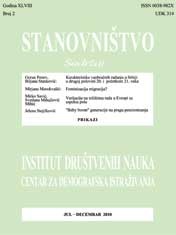Предотвратимая смертность в регионах Российской Федерации
Avoidable Mortality in the Russian Regions
Author(s): Tamara Pavlovna SabgaydaSubject(s): Sociology, Evaluation research, Policy, planning, forecast and speculation, Demography and human biology
Published by: Институт друштвених наука
Keywords: avoidable mortality; preventable causes of death; health care system; the regional heterogeneity of mortality; Russia
Summary/Abstract: The current trends of avoidable mortality, which is an integral indicator of health system performance, were analyzed. The paper discusses the regional heterogeneity of levels and trends in avoidable mortality in the Russian Federation. Also, it contains the analysis of impact of the financial costs of public health on avoidable mortality in regions with different levels of economic development. The last 20-years period was studied, which includes a stage of crisis as well as a social recovery phase. The official data of the State Statistics Committee were analyzed. In Russia, all death cases are registered in accordance to the international classification ICD-10. Special computer program summarizes death cases from preventable causes, and calculates the standardized rates for the population aged from 5 to 64 years. The old European standard of population age structure is used. Estimates of avoidable mortality were made in accordance with the European approach, under which avoidable mortality accumulates deaths of persons aged from 5 to 64 years due to 34 causes and 4 classes of causes. These 38 causes are divided into 3 groups according to three levels of diseases prevention. The level of avoidable mortality in the different regions varies up to 8 times. That is comparable to the difference between Russia and the countries of European Union in 1994. This gap is due to the coexistence of different stages of epidemiological development among the regions in Russia. When death rates increased, it is shown that mortality from causes which are preventable by measures of primary and tertiary prevention increased to a greater extent than mortality from the causes which depend from measures of secondary prevention. Therein, the largest growth of observed mortality was due to low quality of medical care in case of males (group 3), and due to causes which are preventable by measures of primary prevention in case of females (group 1). When mortality was reduced, the rates of change for causes in groups 1 and 3 were approximately the same for both sexes. Avoidable mortality due to late detection of malignant tumors (group 2) has been changed the least. Preventable component defines over 80% of the regional differences in death rates. In 2009, the level of avoidable mortality differed more than fourfold among different regions of the Russia. Similarly, the difference in the level of unavoidable mortality was 1.3-fold and 1.7-fold, for males and females respectively. Proportion of deaths from preventable causes in the total sum of death cases varies from 40% till 75%. Funding for comprehensive programs of public health to a greater extent stimulates the reduction in mortality from preventable causes of the first group. Mortality connected with quality of medical care is more determined by socio-political situation in the country than by regional health care expenses. Based on these results, it is concluded that the action plans to reduce mortality in Russia must have a strong regional specificity, different targets and indicators. Using the proportion of preventable causes, it is possible to separate the regions into groups with different ratios of death determinants, which, therefore, require different approaches to reduce mortality.
Journal: Stanovništvo
- Issue Year: 49/2011
- Issue No: 2
- Page Range: 1-23
- Page Count: 23
- Language: Russian

